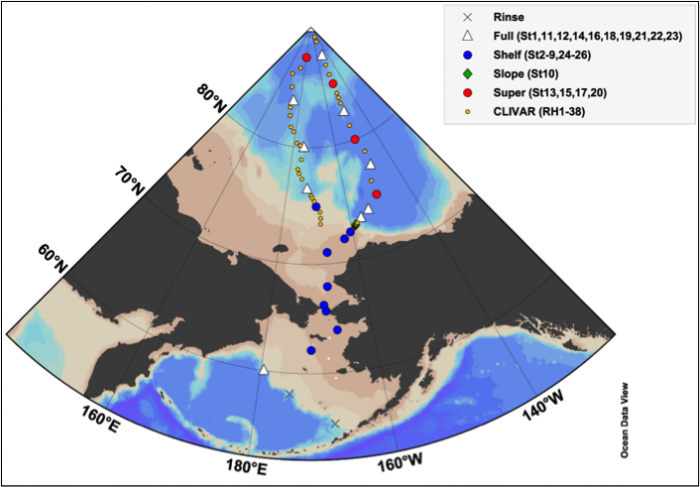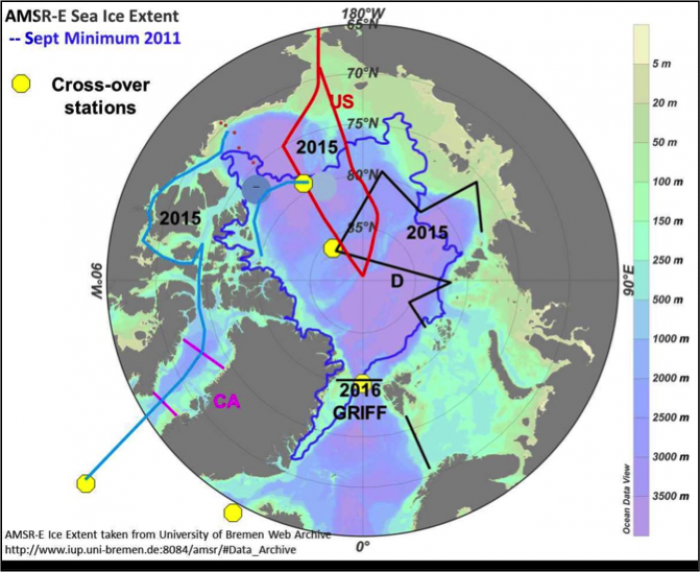By: David Kadko, 2015 Expedition Chief Scientist
A team of 50 scientists, students, and technicians will embark on the U.S. Arctic GEOTRACES expedition this year, 9 August -15 October 2015, aboard the U.S. Coast Guard Cutter Healy. Established by the U.S. GEOTRACES Science Steering Committee, the U.S. Arctic GEOTRACES initiative will be part of an international, multiple icebreaker effort—provided by the United States, Canada and Germany—and will include scientists from several nations who will conduct geochemical sampling of the Arctic Ocean.
GEOTRACES is an international research program focused on the marine biogeochemical cycles of trace elements and isotopes (TEIs) (Henderson et al., 2007). Study of TEIs in the context of ongoing changes in Arctic systems is well justified since trace elements can play dual roles as essential micronutrients, including Iron (Fe), Zinc (Zn), and Cobalt (Co) (Martin et al., 1990 Saito et al., 2002; Coale et al., 2003) and as toxicants such as Arsenic (As) and Copper (Cu) (Sunda and Guillard, 1976; Sanders and Vermersch, 1982), and therefore affect biological productivity and carbon cycling. These and other elements and isotopic tools can trace and determine rates of many geochemical, biogeochemical, and physical processes in the ocean. The GEOTRACES mission is: "To identify processes and quantify fluxes that control the distributions of key trace elements and isotopes in the ocean, and to establish the sensitivity of these distributions to changing environmental conditions." This is highly relevant to the Arctic, where rapid climate change and accompanying biogeochemical responses are occurring. For this reason there has been strong interest in carrying out studies in the Arctic Ocean since the inception of GEOTRACES.

A small ocean with large global impact, the Arctic Ocean offers a unique opportunity to study TEI biogeochemistry in a regime dominated by two ocean sources (Pacific and Atlantic), with major influences from river supply, shelf-basin exchanges, and sea ice. The U.S. GEOTRACES' transect in the western Arctic (see Figure 1) will be augmented by the CLIVAR program, and be done in collaboration with pan-Arctic efforts from a large international community. These expeditions involve the deployment of ice-capable research ships from three nations (the U.S., Canada, and Germany) across different regions of the Arctic Ocean in 2015 (see Figure 2), and application of state of the art geochemical tracers to unravel the complex biogeochemical dynamics of the Arctic Ocean and its continental shelves. As part of the international collaboration, crossover stations will be occupied by more than one country to assist data quality control and better assure inter-laboratory calibration. Scientists from countries without icebreaker capability will also participate in this endeavor. Heretofore, there have been few comprehensive studies of the marine biogeochemical cycles of TEIs in the Arctic Ocean. The combined international program this year will be unprecedented in regional scope and scientific breadth.

The overall sampling program explores the Pacific inflow through the Bering Strait (U.S.), the Arctic outflow to the Atlantic through the Canadian Arctic Archipelago (Canada), exchange between the Arctic and the Atlantic through Fram Strait and the Nordic Seas (Germany), and a comprehensive coverage of the deep Canada and Eurasian basins (U.S., Sweden, Germany, and Canada).
Overarching goals that motivate the GEOTRACES Arctic initiative include:
- Quantify the fluxes of TEIs into and out of the Arctic Ocean through choke points (for example, the Bering Strait);
- Identify the processes that regulate shelf-basin exchange of TEIs and quantify their rates;
- Characterize the sources and transport of TEIs in the Arctic Ocean via aerosols, sea ice, rivers, and sediments;
- Identify processes removing TEIs from the water column and quantify their rates;
- Establish current levels of essential micronutrients and of potentially toxic TEIs as a reference for future change;
- Describe and quantify the time-varying change in the TEI chemistry of deep water as it mixes westward from the Atlantic Ocean into the Canadian Basin; and
- Better define the relationship of TEIs to the hydrographic, carbon, and tracer distributions, which form the core of our present knowledge of Arctic waters and circulation.
This mission is part of the greater GEOTRACES mission described above. This program is being carried out in every global ocean basin by the United States and international partners. To date, the U.S. has conducted missions in the North Atlantic and the Eastern Equatorial Pacific.
For further information contact Dr. David Kadko, chief scientist (dkadko [at] fiu.edu).
References
Coale, K.H., Wang, X.J., Tanner, S.J., and K.S. Johnson (2003). Phytoplankton growth and biological response to iron and zinc addition in the Ross Sea and Antarctic Circumpolar Current along 170°W. Deep-Sea Res. II 50, 635– 653.
Henderson, G.M., Anderson, R.F., et al., (2007). GEOTRACES - An international study of the global marine biogeochemical cycles of trace elements and their isotopes. Chemie Der Erde-Geochemistry, 67(2): 85-131
Martin, J.H., S. E. Fitzwater and R. M. Gordon (1990). Iron deficiency limits phytoplankton growth in Antarctic waters, Global Biogeochem. Cycl., 4: 5-12.
Saito, M.A., J.W. Moffett, S.W. Chisholm, and J.B. Waterbury. (2002). Cobalt limitation and uptake in Prochlorococcus. Limnol. Oceanogr. 47: 1629–1636.
Sanders, J.G. and P.S. Vermersch. (1982). Response of marine phytoplankton to low levels of arsenate. J. Plankton Res. 4:881-893.
Sunda, W., and R.R.L. Guillard. (1976). The relationship between cupric ion activity and the toxicity of copper to phytoplankton. J. Mar. Res. 34: 511–529.
